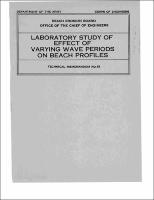Please use this identifier to cite or link to this item:
https://hdl.handle.net/11681/3415Full metadata record
| DC Field | Value | Language |
|---|---|---|
| dc.contributor | United States. Army. Office of the Chief of Engineers | - |
| dc.contributor.author | Watts, George M. | - |
| dc.date.accessioned | 2016-03-16T15:42:30Z | - |
| dc.date.available | 2016-03-16T15:42:30Z | - |
| dc.date.issued | 1954-09 | - |
| dc.identifier.uri | http://hdl.handle.net/11681/3415 | - |
| dc.description | Technical Memorandum | - |
| dc.description | From the Introduction: The accuracy of evaluating a beach erosion problem by an engineer is in part dependent upon his understanding of the fundamental principles involved. In obtaining basic information for an erosion study it is at times uneconomical or not feasible to perform the investigation in a natural environment; consequently, laboratory models based on the principles of hydraulic similitude are employed when practicable to assist in solving the problem. Such has been the case of the study of beach profiles as related to the changes that occur when beaches are subjected to attack by waves of various characteristics. There are many variables which influence the movement of material on a beach under wave attack and it has seemed best to approach the laboratory study by isolation of certain variables. When all variables and their quantitative effects in producing the beach profiles are fully understood, a quantitative study incorporating all variables will be possible. One of the initial projects of the Beach Erosion Board pointed toward gaining a quantitative understanding of beach profile changes (1) used wave trains of a constant period. This study demonstrates the effect of certain physical factors which control the equilibrium profile of a beach and the interrelation of these factors insofar as beaches at laboratory scale are concerned. A survey indicates that the use of single-period wave trains prevails at present in most small-scale wave tank tests designed to study changes in beach profiles, including the study mentioned above. It is believed that such wave trains unduly accentuate profile irregularities peculiar to the wave period used. The purpose of this present study is to determine the desirable magnitude and frequency of variations in wave periods in wave tank tests, in order to eliminate profile irregularities resulting from the use of a fixed period, and thereby, approximate more marly the profiles resulting from a natural wave train with its variety of components. | - |
| dc.publisher | United States, Beach Erosion Board | - |
| dc.publisher | Engineer Research and Development Center (U.S.) | - |
| dc.relation | http://acwc.sdp.sirsi.net/client/en_US/search/asset/1007700 | - |
| dc.relation.ispartofseries | Technical memorandum (United States. Beach Erosion Board) ; no. 53. | - |
| dc.rights | Approved for Public Release, Distribution is Unlimited | - |
| dc.source | This Digital Resource was created from scans of the Print Resource | - |
| dc.subject | Beach erosion | - |
| dc.subject | Water waves | - |
| dc.subject | Wave tank | - |
| dc.subject | Wave tank experiment | - |
| dc.subject | Offshore bars | - |
| dc.subject | Offshore troughs | - |
| dc.title | Laboratory study of the effect of varying wave periods on beach profiles | - |
| dc.type | Report | en_US |
| Appears in Collections: | Technical Memorandum | |
Files in This Item:
| File | Description | Size | Format | |
|---|---|---|---|---|
| BEB-TM-53.pdf | 9.09 MB | Adobe PDF |  View/Open |